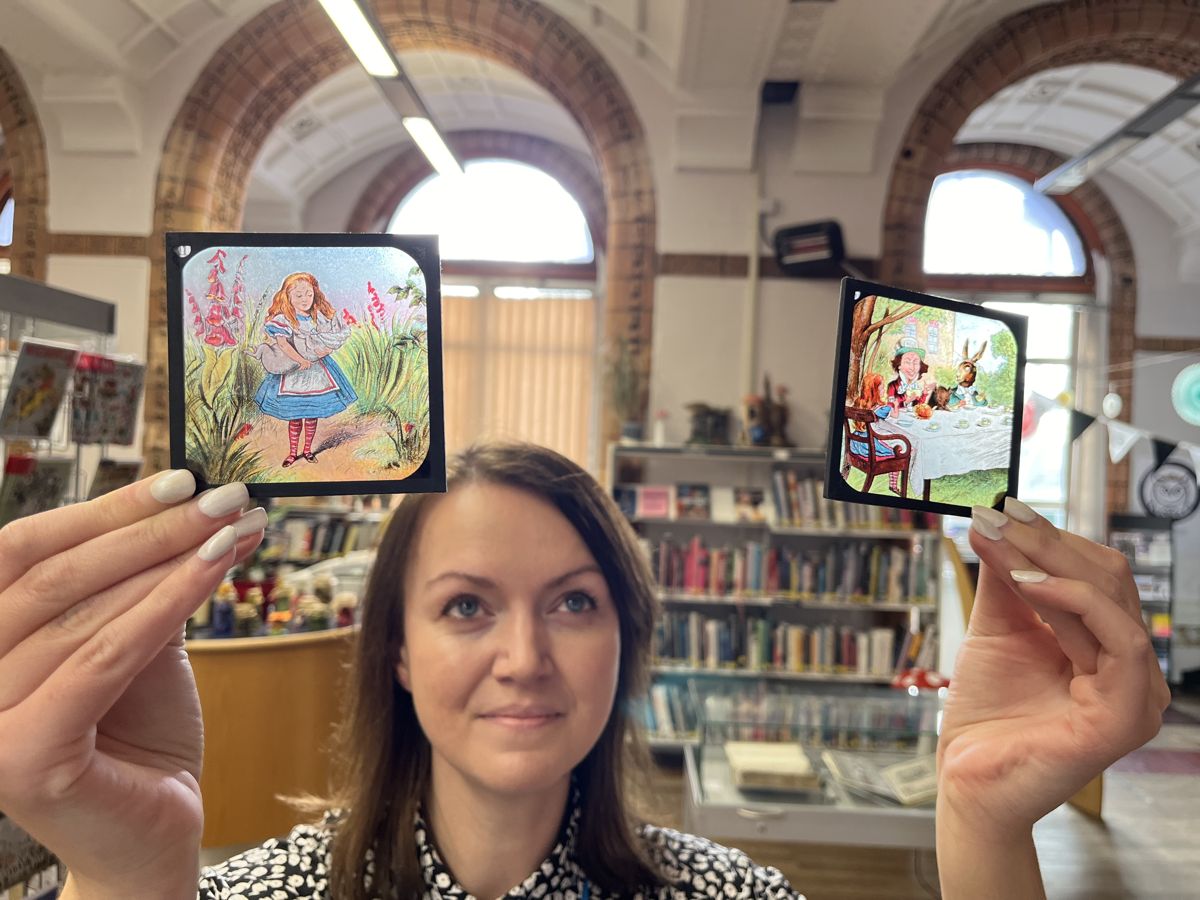Visitors to Leeds Central Library’s “Fantasy: Realms of Imagination” exhibit can step into literary history with vintage magic lantern slides from circa 1906, featuring scenes from beloved tales like Alice in Wonderland and Peter Pan. These colourful glass relics, once used for storytelling through projection, highlight the artistry and enduring influence of fantasy in early 20th-century entertainment.
What can visitors expect to see at the Vintage Magic Lantern Slides exhibit in Leeds Central Library?
Visitors to Leeds Central Library’s “Fantasy: Realms of Imagination” can marvel at vintage magic lantern slides from circa 1906, showcasing scenes from classic tales like Alice in Wonderland and Peter Pan. They’ll experience a historical storytelling method using these coloured glass slides, reflecting the artistry and influence of fantasy in early 20th-century entertainment.
Vintage Visions of Classic Tales
The corridors of Leeds Central Library have become a temporal gateway, inviting visitors to journey through literary history via a stunning assemblage of vintage magic lantern slides. Dating back to circa 1906, these coloured glass relics depict vibrant scenes from beloved narratives such as Alice in Wonderland, Peter Pan, and Aladdin. The exhibit, part of an initiative titled “Fantasy: Realms of Imagination”, offers a glimpse into the ways classic fairy tales have spellbound audiences across generations.
Each slide, crafted with meticulous attention to detail, was once a centerpiece for entertainment in the early 20th century, intended for projection by a magic lantern. These portable devices would cast the illustrated scenes onto walls or screens, accompanied by an orated script, piecing together a storytelling experience that predated modern cinema. The library’s showcase not only highlights the artistry of these slides but also reflects on fantasy’s pervasive role in moulding folklore, fiction, and entertainment.
Special Collections Librarian Rhian Isaac notes, “These beautiful slides really do capture the vibrancy and colour that we associate with the classic fairy tales we’ve all come to know so well, and it’s easy to picture them enthralling an audience in the early 20th century.” The collection reveals the transformative power of storytelling and the timeless appeal of reinterpreted tales, continuing to resonate through the ages.
A Tapestry of Imagination
Further enriching the Leeds Central Library’s exhibition, “Fantasy: Realms of Imagination”, are additional artifacts that span a wide cultural spectrum. On display are editions of Grimms Fairy Tales and Alice’s Adventures in Wonderland, each page graced with Arthur Rackham’s iconic illustrations. These works sit alongside Gulliver’s Travels and a Shakespearean classic, A Midsummer Night’s Dream, forming an anthology of imagination that transcends time.
In a nod to the exhibition’s multidisciplinary approach, ancient Greek coins over two millennia old, featuring mythical figures like the Gorgon and Pegasus, have been lent by Leeds Museums and Galleries. This historical connection underscores the deep roots of fantastical storytelling. Visitors can also encounter the influence of fantasy on contemporary culture, with references to popular TV series such as Xena: Warrior Princess and Buffy the Vampire Slayer.
A breathtaking installation by fantasy artist Anne Stokes features a duo of dragons vigilantly guarding their eggs, underscoring the genre’s ability to enchant through visual art as well as narrative. This diverse collection of exhibits and events aims to celebrate the genre’s indelible impact on culture and inspire both nostalgia and discovery among its audience.
From Leeds Central to Citywide
After January 17, 2024, when the main exhibition at Leeds Central Library concludes, “Fantasy: Realms of Imagination” will extend its reach across the city. Selected parts of the collection are set to be displayed at Chapel Allerton Library from January 22, Beeston Library and Community Hub from February 5, and Holt Park Library and Community Hub from February 19. This move ensures that the magical experience will not be confined to a single location but rather shared with a broader audience.
Councillor Mary Harland, Leeds City Council’s executive member for communities, expressed her enthusiasm for the exhibition: “Leeds Central Library’s remarkable exhibition has been a wonderful exploration of the fantasy genre and the influence it has had on so many aspects of our culture.” She highlights the exhibition’s dual impact of rekindling fond memories for some while encouraging a new generation to delve into these extraordinary narratives.
Those interested in delving deeper into this enchanting world can find the full schedule of events and further details at Fantasy: Realms of Imagination. This extensive program is designed to complement the physical exhibition, adding layers of engagement through various events and activities, thus offering a comprehensive celebration of the fantasy genre’s contribution to collective imagination.
For further details or to view the full events program, please visit Fantasy: Realms of Imagination (leeds.gov.uk).
- Leeds Central Library’s “Fantasy: Realms of Imagination” exhibit features vintage magic lantern slides from circa 1906 depicting scenes from classic tales like Alice in Wonderland and Peter Pan.
- The magic lantern slides were used for storytelling through projection and showcase the artistry and enduring influence of fantasy in early 20th-century entertainment.
- The exhibit also includes editions of Grimms Fairy Tales and Alice’s Adventures in Wonderland with illustrations by Arthur Rackham, ancient Greek coins featuring mythical figures, and references to popular TV series like Xena: Warrior Princess and Buffy the Vampire Slayer.
- After the main exhibition at Leeds Central Library concludes on January 17, 2024, selected parts of the collection will be displayed at other libraries across the city.
- The exhibition aims to celebrate the fantasy genre’s impact on culture and inspire both nostalgia and discovery among its audience.
